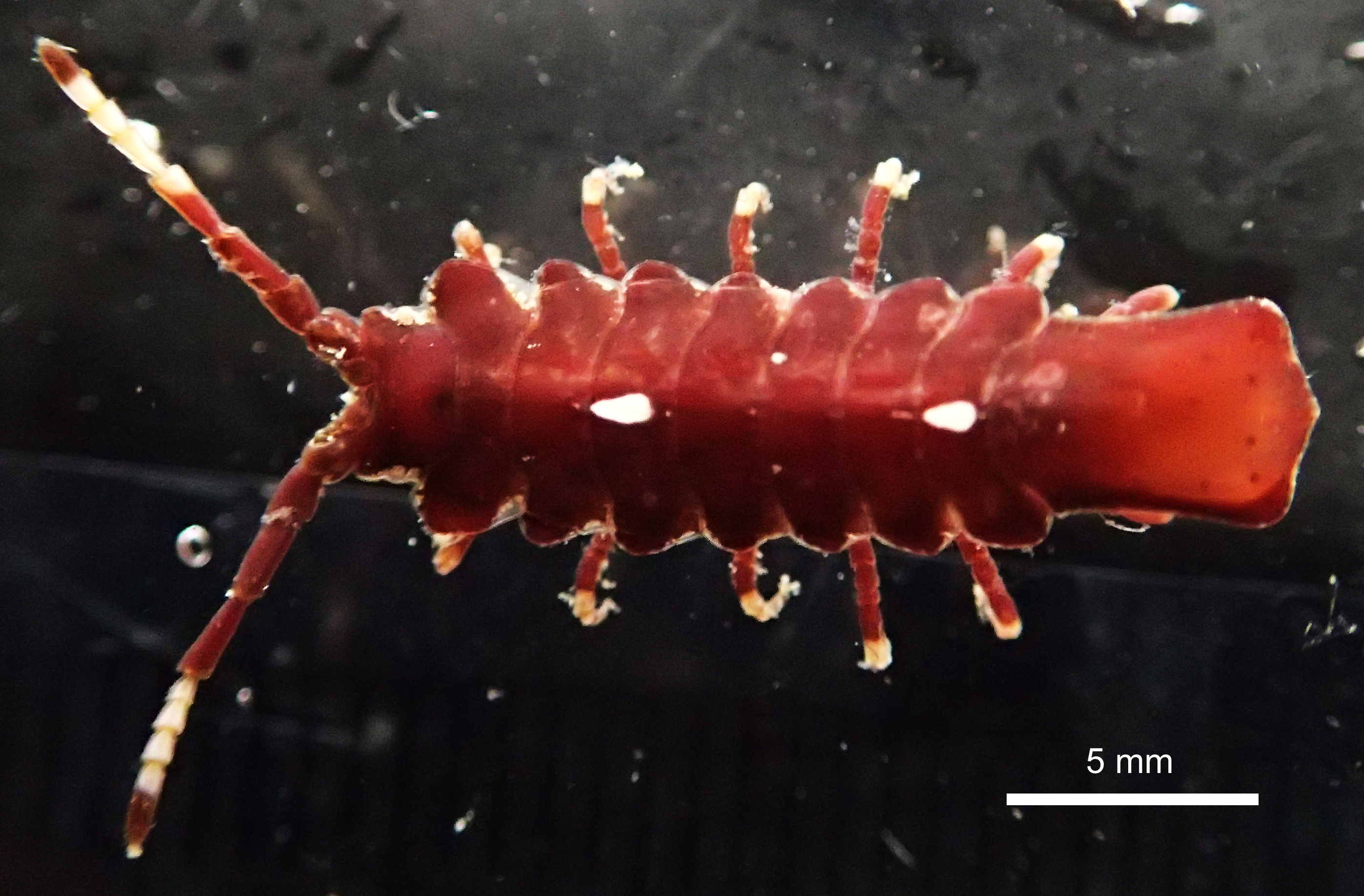A valviferan was obtained in the intertidal zone of Oshoro Bay, Hokkaido, Japan, about 43°12′N, 140°51′E, on 2 June 2014 by Ayako Hagiwara. It was photographed and fixed in 99% EtOH by Takumi Onishi; the specimen was tentatively identified as Paridotea robusta Nunomura, 1985 by a reference to Nunomura (1995). Total DNA was extracted from posterior the one leg of the body using the silica method (Boom et al. 1990) with some modifications. Extracted DNA was dissolved in 30 µl of deionized water and has been preserved at –20°C. Remaining morphological voucher specimen has been deposited at the Hokkaido University Museum under the catalogue number ICHU2110352 (contact: Dr. Hiroshi Kajihara, kazi@mail.sci.hokudai.ac.jp).
An about 400-bp fragment of the mitochondrial 16S rRNA gene was amplified by polymerase chain reaction (PCR) using ar-L (5′-CGCCTGTTTATCAAAAACAT-3′) and br-H (5′-CCGGTCTGAACTCAGATCACGT-3′) (Palumbi et al. 1991). A hot start PCR was performed by a thermal cycler, 2720 Thermal Cycler (Applied Biosystems), in a 20-µl reaction volume containing 1 µl of template total DNA (approximately 10–100 ng) and 19 µl of premix made with 632-µl deionized water, 80-µl Ex Taq Buffer (TaKara Bio), 64-µl dNTP (each 25 mM), 8-µl each primer (each 10 µM), and 0.1-µl TaKara Ex Taq (5 U/µl,TaKara Bio). Thermal cycling condition comprised an initial denaturation at 95°C for 30 sec; 30 cycles of denaturation at 95°C for 30 sec, annealing at 45°C for 30 sec, and elongation at 72°C for 45 sec; and a final elongation at 72°C for 7 min. Prior to this, an attempt to amplify the mitochondrial cytochrome c oxidase subunit I gene (COI) using the primer pair LCO1490 (5′-GGTCAACAAATCATAAAGATATTGG-3′) and HCO2198 (5′-TAAACTTCAGGGTGACCAAAAAATCA-3′) (Folmer et al. 1994) had been unsuccessful.
The PCR product was purified with the silica method (Boom et al. 1990). Both strands were sequenced with a BigDye® Terminator v3.1 Cycle Sequencing Kit (Applied Biosystems) following the manufacturer's protocol, using the same primer set as the initial PCR amplification. Sequencing was performed with ABI Prism 3730 DNA Analyzer (Applied Biosystems). Chromatogram and sequence data were operated with MEGA v5 software (Tamura et al. 2011).
Results
Phylum Arthropoda
Class Malacostraca
Order Isopoda
Family Idoteidae Samouelle, 1819
Genus Paridotea Stebbing, 1900
cf. Paridotea robusta (Nunomura, 1985)
[Japanese name: mononohu-heramushi]
(Fig. 1)
A partial sequence with a 434-bp strech of the mitochondrial 16S rRNA gene was determined from our material tentatively identified as Paridotea robusta (see Appendix). A nucleotide BLAST search (Altschul et al. 1997) at the NCBI website (https://blast.ncbi.nlm.nih.gov/) showed that our sequence from Oshoro was most similar to AF260856 (100% in query coverage; E value = 1e-139; 88% identity), a sequence of a valviferan identified as "Idotea wosnesenskii"(Wetzer 2001). There was no 16S sequence of P. robusta deposited in GenBank as of writing.

Fig. 1. A valviferan tentatively identified as Paridotea robusta (Nunomura, 1985) (ICHU2110352) from Oshoro Bay, Hokkaido, Japan; a photograph taken in life showing its body color and characteristic shape of the lateral edge in each pereonite tegrum from dorsal view.
References
Altschul, S. F., Madden, T. L., Schaffer, A. A., Zhang, J., Zhang, Z., Miller, W. and Lipman, D. J. 1997. Gapped BLAST and PSI-BLAST: a new generation of protein database search programs. Nucleic Acids Research 25: 3389–3402.
Boom, R., Sol, C. J. A., Salimans, M. M. M., Jansen, C. L., Wertheim-van Dillen, P. M. E., and van der Noordaa, J. 1990. Rapid and simple method for purification of nucleic acids. Journal of Clinical Microbiology 28: 495–503.
Folmer, O., Black, M., Hoeh, W., Lutz, R. and Vrijenhoek, R. 1994. DNA primers for amplification of mitochondrial cytochrome c oxidase subunit I from diverse metazoan invertebrates. Molecular Marine Biology and Biotechnology 3: 294–299.
Nunomura, N. 1995. Isopoda. Pp. 205–233. In: Nishimura, S. (Ed.) Guide to Seashore Animals of Japan with Color Picturea and Keys, Vol. II. Hoikusha, Osaka. [In Japanese].
Tamura K, Peterson D, Peterson N, Stecher G, Nei M, Kumar S. 2011 MEGA5: Molecular Evolutionary Genetics Analysis Using Maximum Likelihood, Evolutionary Distance, and Maximum Parsimony Methods.Molecular Phylogenetics and Evolution 28: 2731–2739.
Wetzer, R. 2001. Hierarchial analysis of mtDNA variation adn the use of mtDNA for isopod systematics (Crustacea: Isopoda). Contributions to Zoology 70: 23–39.
Appendix
Mitochondrial 16S rRNA gene partial sequence (434 bp) from ICHU 2110352 tentatively identidied as Paridotea robusta (Nunomura, 1985), collected in Oshoro Bay, Hokkaido, Japan.
TGATTTATAAATGGCCGCAGTATCCTGACTGTGCTAAGGTAGCATAATCACTTGTCTTTTAATTAAAGGCTAGAATGAACGGTATGACGAGAGAAGAACTTTCTTAACCAAATTTTGAAAACTTATCCTGAGAGTTAAAAGACTCTCAAAACTTAGGGGGACGACAAGACCCTATAAAACTTTACCCCCTACTCAACTTGATCTTAAGTGAAAAAGTAATGACTAAGAGGTTCTGCTGGGGCGGCAAACTTTTAAACCTAACATAATTTAAATCAACTCTTCGAAGATTTTCACGCACCTGACTAAAGAATAAGAACAAGTTACTTTAGGGATAACAGCGTTATACCTTTTAAGAGCCCCTATTGCCAAAGGTGTTTACGACCTCGATGTTGAATTGAAGTACCTACCTTAAGCAACATTAAGATAAGGAAGTC